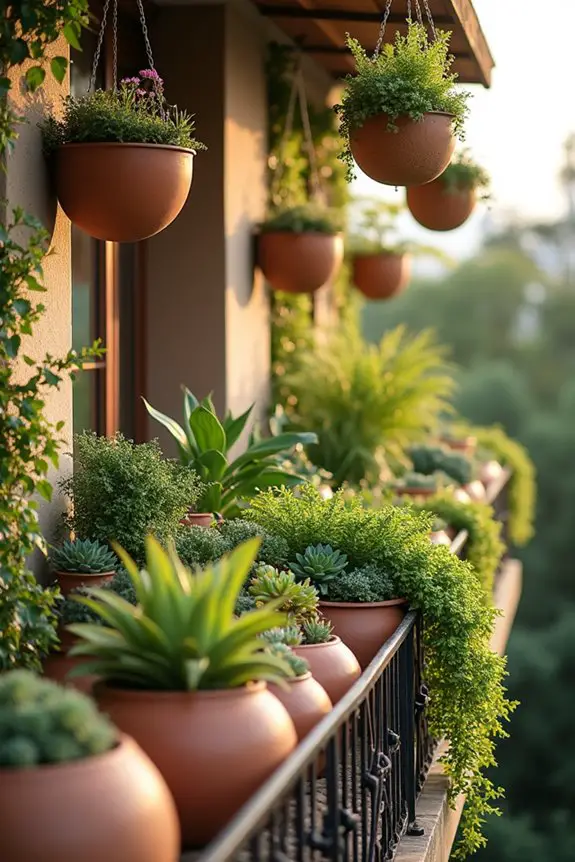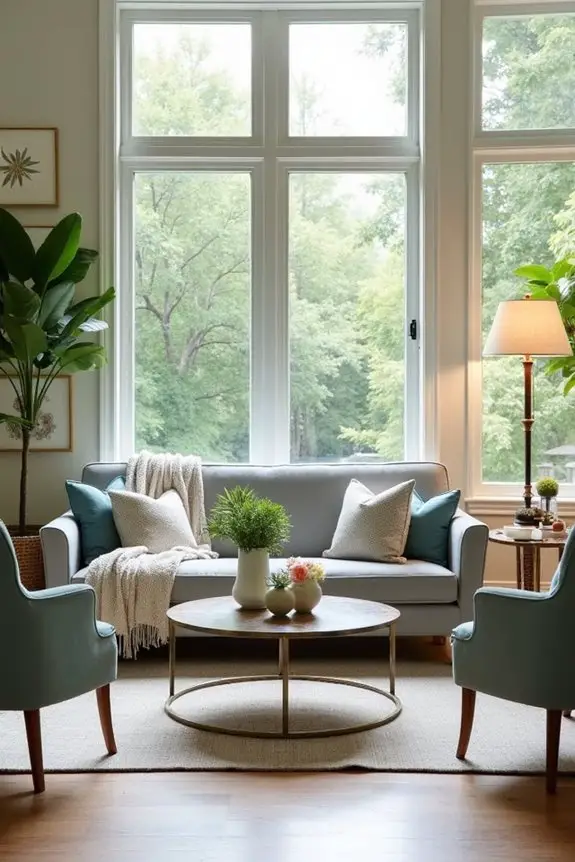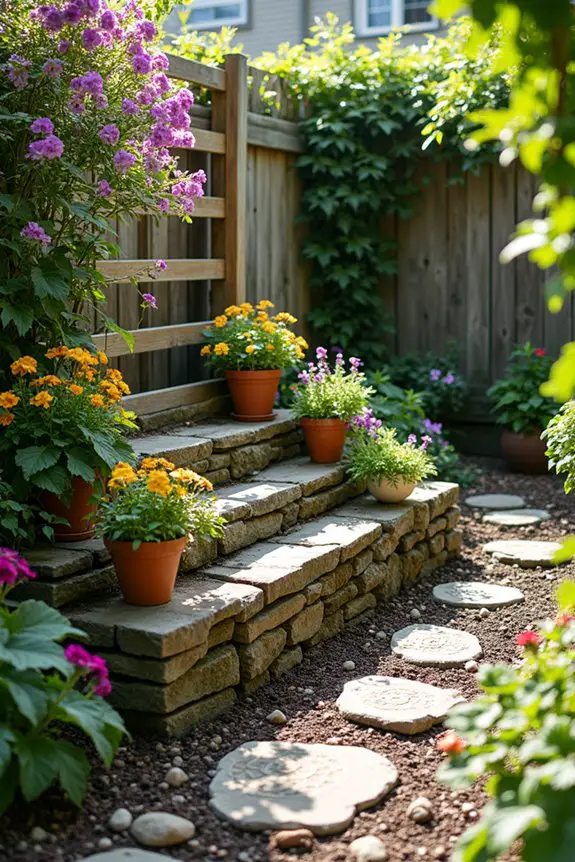So, you’ve got a balcony that feels more like a forgotten corner than an oasis, huh? Don’t worry, you’re not alone. Imagine transforming that space with vibrant flowers and herbs, making it a cozy retreat. Think vertical planters and hanging pots, all with that personalized touch. It can be a bit of a puzzle, but once you crack the code, your balcony dreams will come true. Let’s explore those 10 garden designs—trust me, they’re worth considering.
Vertical Garden Planters
Have you ever thought about how a vertical garden can transform your balcony?
Imagine lush blooms and vibrant greens creating a stunning backdrop, all while you sip your morning coffee.
Plus, using eco-friendly materials and innovative containers makes you feel good knowing you’re helping the planet, right?
1. Floral Arrangement Aesthetic
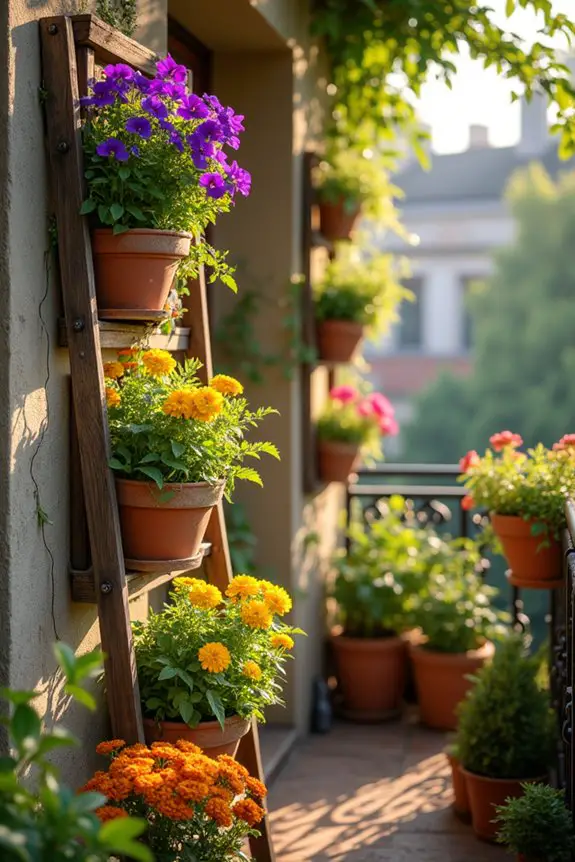
When it comes to creating a balcony garden that truly pops, floral arrangement aesthetics through vertical planters can take your space from drab to fab in no time. Not only do these planters save space, making the most out of limited square footage, but they also create a lush, vibrant vibe that feels like a mini oasis right outside your door.
Imagine sipping your morning coffee surrounded by cascading blooms and fragrant herbs. Glorious, right? Let’s plunge into how you can achieve this floral wonderland.
First things first, choose your vertical garden planters. They can range from wall-mounted pockets to ladder-style shelves or even hanging planters—there’s no shortage of options.
For instance, if you’re a bit of a perfectionist (like me, sigh), wall-mounted planters can give that clean, organized look while still allowing for a fun mix of textures and colors. But if you prefer a more rustic feel, you might find yourself drawn to some quirky, climbing ladders adorned with terracotta pots.
Next, it’s time to select your plants. Go for a delightful mix of flowers, herbs, and even some colorful foliage. Think vibrant petunias, sweet-smelling basil, or maybe even trailing ivy that can spill over the edges of your planter. Trust me, mixing some herbs in there not only adds a pop of green but also gives you an excuse to be that friend who brings fresh basil to dinner parties.
You’re welcome, by the way. Just make sure you check how much sun each plant needs and tailor your selection to the amount of light available on your balcony.
Now, let’s talk arrangement. When planting, layer taller plants at the back and shorter ones in the front. This creates depth and guarantees every bloom gets its moment in the spotlight.
And here’s a little pro-tip: if you’re a bit forgetful (who hasn’t accidentally let a plant go too long without water?), consider using self-watering planters. They’re like the “adulting” of gardening, taking some pressure off your busy lifestyle. These planters can also help ensure that your plants receive consistent moisture, making them ideal for maintaining a flourishing balcony garden with self-watering hanging planters.
To add a bit of flair, think about incorporating decorative elements. Maybe some twinkly fairy lights to make everything look charming at night, or even a cute little garden statue between your plants—kind of like your garden’s Snapchat filter.
Just be careful not to overdo it; we don’t want your space to turn into a garden flea market.
And finally, maintenance is key. Regularly check for dead leaves or any pesky bugs. A little bit of love goes a long way in keeping your balcony garden healthy and thriving.
Making a schedule can be super handy; mark your calendar, or set reminders on your phone. Whatever it takes to keep those blooms blooming and you feeling proud of your green thumb.
2. Sustainable Materials Approach
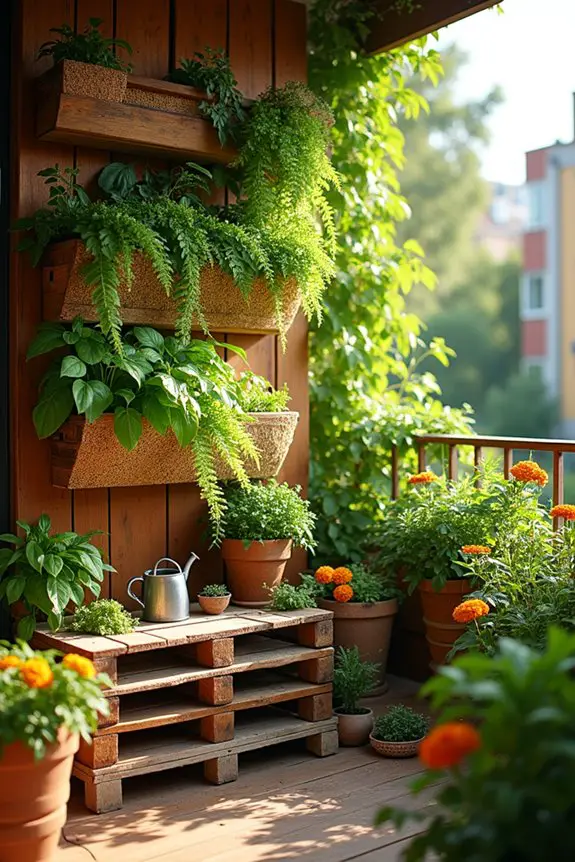
When it comes to balcony gardening, using sustainable materials for your vertical garden planters is a game-changer. Not only does it help our planet, but it also gives your space a unique, earthy vibe. Imagine stepping out onto your balcony, surrounded by greenery, all while knowing you made eco-friendly choices. It feels good, right? Let’s explore how to create a sustainable setup that’s both functional and stylish.
First off, think about the materials you choose for your vertical planters. Recycled wood, bamboo, or even repurposed plastic containers work wonders. You might’ve some old wooden pallets lying around, and they’re perfect for crafting a rustic vertical garden. Just sand them down a bit—trust me, you don’t want splinters ruining your gardening fun—and then stack them vertically against a wall. Additionally, a wood raised bed kit can provide an excellent foundation for your garden if you want to create a more structured setup.
The beauty of using wood isn’t just in its looks but also in its ability to breathe, providing a cozy home for your plants.
Now that you’ve got your base sorted, consider the types of pots or containers you want to use. Opt for biodegradable pots made from coconut coir or recycled paper. These aren’t only stylish but will break down over time, enriching your soil instead of cluttering landfills. Additionally, utilizing biodegradable garden twine can enhance your garden’s aesthetic while supporting plant growth sustainably.
Also, if you have any empty yogurt cups (yes, that’s right, those containers can be garden heroes), poke some holes in the bottom for drainage, and voilà, you have a new home for your tiny seedlings.
Next up, think about how to set everything up. Balance is key. Stick to a color palette that feels natural—think earthy tones or even a monochromatic scheme with varying shades of green. By unifying your color choices, you create a calm, cohesive look that invites serenity.
And here’s a little gardening hack: when planting, make sure each pot has good drainage. Nobody likes soggy roots, not even the plants.
And let’s not forget about composting. If you’re inching toward being an eco-warrior like me, consider making your own compost. Toss vegetable scraps, coffee grounds, and even those old leaves into a compost bin, and over time, you’ll have rich, nutrient-dense soil ready to give your plants a boost.
You’ll feel like a gardening guru when you sprinkle your homemade compost around, and your plants will definitely appreciate the effort.
Lastly, regularly check your planters for any signs of wear and tear. With sustainable materials, they mightn’t last as long as traditional plastic, but that’s okay. It’s the cycle of life.
As the containers slowly break down, think of it as giving back to Mother Earth. Plus, you can always repurpose new materials to keep the green fun going.
3. Lighting and Color Harmony
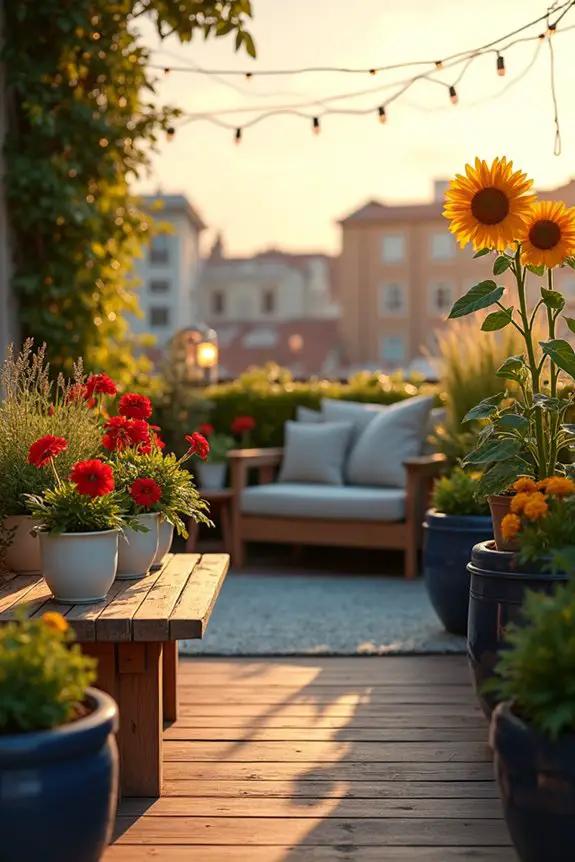
When designing a balcony garden, lighting and color harmony are your best friends. Let’s face it—who doesn’t want to step outside and feel an instant mood boost from the right combination of light and colors? It’s not just about having plants; it’s about creating an inviting atmosphere that makes you want to hang out there for hours.
First things first, let’s chat about lighting. Most balcony gardens are limited on light, so think strategically about where to place your planters. If your balcony gets a lot of sunlight during the day, try using lighter-colored pots. This not only reflects some of that sunlight, keeping the soil cooler and your plants happier, but it also adds a fresh aesthetic. Envision soft whites, pale greens, or light terracotta that almost glows in the sun—beautiful, right? Adding a solar greenhouse fan can also help circulate air and maintain a comfortable temperature for your plants.
On the flip side, if you have a shady balcony, go bold with darker pots to create a cozy, intimate vibe. Deep greens, rich browns, or even navy can work wonders—just think of it like dressing your space for a chill evening.
Now, think about the plants themselves. Group your greenery according to their sun needs and colors. This is where color harmony truly shines. Pair lush greens with vibrant blooms like red geraniums or yellow marigolds. The contrast will make your garden pop and draw the eye, like a gallery of nature right outside your home. Don’t hesitate to play with different heights, either! Tall plants like sunflowers or grasses can serve as a striking backdrop, while trailing plants like ivy can create beautiful cascades from your upper planters.
Alright, here’s a tip that might save you some gardening heartache: always observe how the sunlight hits your balcony throughout the day before planting. Grab your cup of coffee (or your favorite gardening beverage) and just relax out there for a moment. Watch those shadows dance. Trust me, knowing this can save you from the heartache of coming out to find your plants half-dead from insufficient light later on.
And let’s not forget about accessorizing your garden. String lights or lanterns can breathe life into your balcony during the evening hours. Visualize this: you, a soft glow of fairy lights illuminating your plants, a good book in one hand, and a glass of iced tea in the other. Bliss, right? Just make sure those lights are energy-efficient—because yes, we’re still saving the planet here. Using solar garden lights will not only illuminate your space, but also help reduce your energy consumption.
In the end, creating a balcony that marries lighting and color is like putting together a fabulous outfit. It takes a little thought and care, but the payoff is so worth it. You’ll have an oasis that not only looks good but also feels right. What’s not to love about a space designed for relaxation and joy?
4. Eco-Friendly Plant Selection
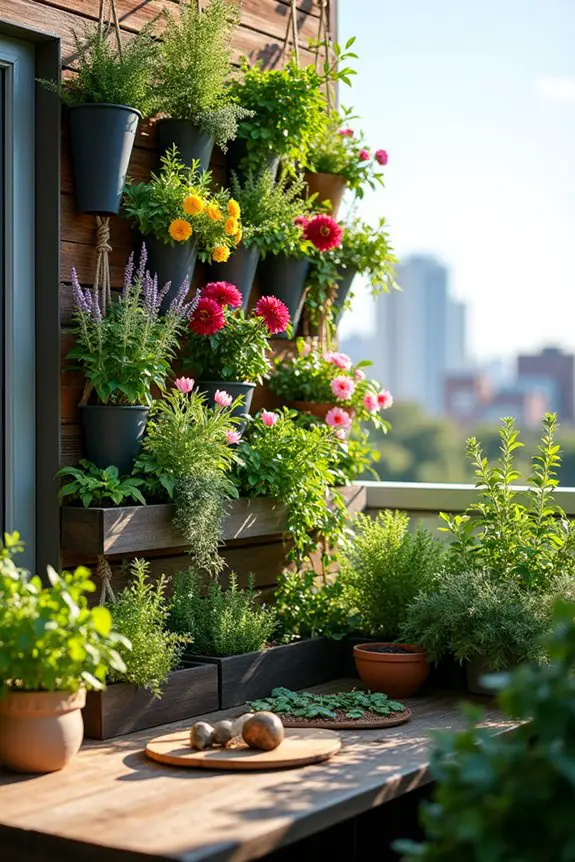
When designing a balcony garden, one of the most effective ways to maximize your space while choosing eco-friendly options is by pondering vertical garden planters. They’re not just functional; they add a delightful vibe, turning any balcony into a lush oasis without taking up precious floor space.
Plus, who doesn’t want to feel like they’re living in a mini forest, right?
To get started with your vertical garden, first things first, pick your planters wisely. Think lightweight materials like recycled plastic, wood, or even metal. These not only look great but also support your eco-friendly mission.
If you’re feeling crafty, you could even make your own planters from reclaimed wood. Just a few screws and some creative spirit, and voilà—you’ve got a bespoke planter that has a story to tell.
Once you have your planters, it’s time to contemplate the plants. Opt for native species or herbs. Not only do they support your local ecosystem, but they also thrive better in their natural environment.
How about starting with an aromatic herb garden? Visualize this: basil, mint, and rosemary swinging happily in your vertical garden, ready to spice up all your meals (and make your balcony smell delicious).
You can even follow the classic rule of “thrillers, fillers, and spillers.” For thrillers, go with taller plants like dahlias or lavender; for fillers, think robust geraniums, and for spillers, consider trailing plants like string-of-hearts or ivy.
Placement is vital—hang your planters at varying heights to create depth and interest. You could use macramé hangers for a boho touch or wall-mounted shelves if you want a more modern look.
Just imagine standing on your balcony, surrounded by lush greenery, with the warm sun kissing your skin—sounds idyllic, doesn’t it?
Watering can be both a joyful routine and a tiny chore, but don’t fret! Think about self-watering vertical planters. They can make your life so much easier and guarantee your plants always have the moisture they need (because who’s time to water every day?).
When you’re watering by hand, try to do it in the early morning or late evening to avoid evaporation.
5. Innovative Container Options
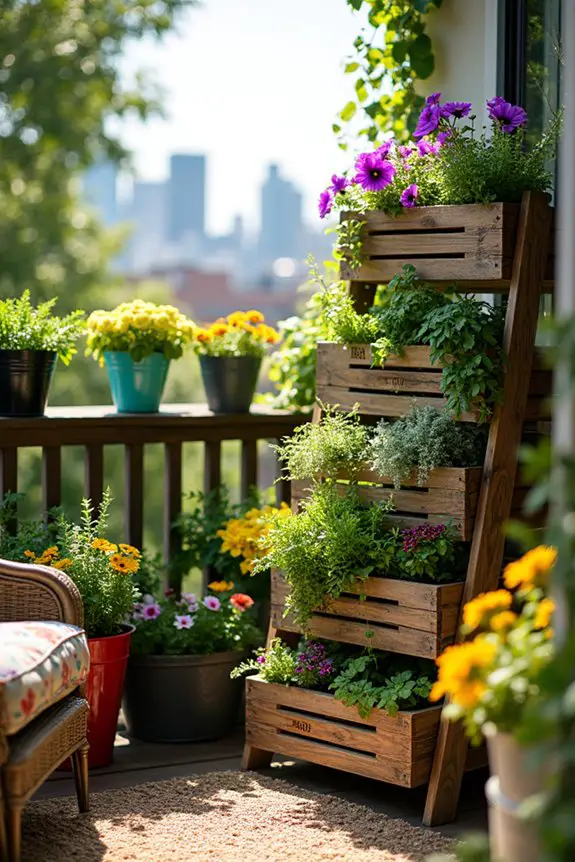
When you think about balcony gardens, have you ever pictured a dynamic setup bursting with greenery that not only saves space but also elevates your outdoor aesthetic? Well, welcome to the world of innovative container options that take your vertical gardening to a whole new level. Not only are vertical planters a practical way to optimize your limited space, they also create a vibrant, inviting atmosphere that makes even the smallest balconies feel like an enchanted escape.
Let’s explore the various container options that you can use to get your garden off the ground—literally. Start with wall-mounted planters or tiered plant stands, which are stellar for maximizing surface area on walls or railings. Imagine cascading plants flowing down like a green waterfall; it’s pure magic. You can create a stunning visual by grouping similar pots together or mixing different textures and colors for a more eclectic look.
Be mindful of the weight, especially if you’re in a high-rise, and use lighter materials like fabric or plastic to keep things chipper.
Another unique option is using old wooden crates or even metal buckets to give your garden a rustic flair. These containers evoke a farmhouse charm while also being functional. Just make sure they’ve good drainage—nobody likes a soggy bottom, not even your plants. To follow this, remove the bottom of the crates and line the interiors with landscaping fabric, allowing water to escape while keeping the soil intact.
Fill them with your chosen plants, and voilà—you’ve got a stylish, upcycled planter that tells a story without breaking the bank.
Speaking of stories, you might want to personalize your containers. Think about painting or decorating them with fun designs or quotes. You could channel your inner Picasso while keeping things expressive—after all, it’s your garden, and it should reflect your personality.
While you’re at it, try labeling your herbs or plants; it’s super helpful when you’re hunting for the freshest basil to brighten up your pasta dish or identifying which succulent is which (no more “mystery plant” scenarios!).
And don’t forget about the advantages of modular planter systems. These systems can be rearranged as the seasons change or as your gardening enthusiasm waxes and wanes (believe me, I’ve been there).
Need a pop of color in winter? Swap out some plants for florals, and voilà, you’ve got an ever-evolving balcony display. This flexibility allows you to experiment without committing to a specific style for too long.
At the end of the day, finding innovative container options doesn’t have to be overwhelming. Lean into your creativity, embrace trial and error, and have fun with it.
After all, it’s your little green sanctuary, and who doesn’t want to feel like a gardening superstar, even on a small balcony? So grab those pots and start making plant magic today. Your future self, cozy on the balcony with a nice cup of tea and a beautiful view, will thank you.
6. Space Optimization Techniques
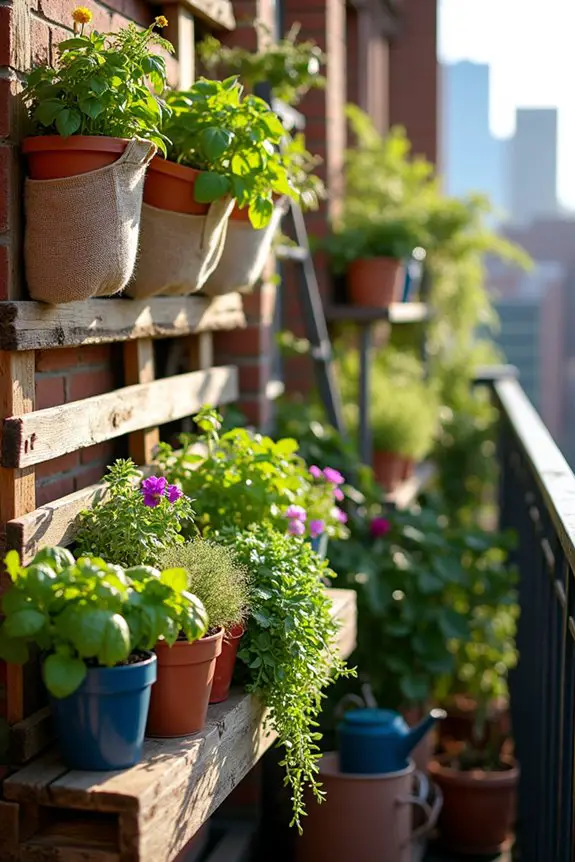
If you’re working with limited balcony space, vertical garden planters are your best friends. Not only do they make efficient use of every inch, but they also create a lush, inviting vibe that can transform even the tiniest outdoor area into a green oasis. Imagine stepping out onto your balcony, surrounded by vibrant leaves and colorful blooms? That’s what vertical gardening can do for you.
Let’s explore how you can set up your very own vertical garden. First off, decide on the type of vertical planter you want. There are wall-mounted pockets, ladder-like shelves, or even repurposed pallets. If you’re a bit on the crafty side, a wooden pallet can be a fun DIY project.
All you need to do is lean it against a wall, fill the gaps with potting soil, and tuck in your favorite herbs or flowers. It’s a conversation starter and a little bit of art rolled into one.
When selecting plants, reflect on their sunlight requirements and how much space they’ll need to grow. You wouldn’t want your sun-loving petunias playing hide-and-seek with shade-loving ferns.
Try mixing different kinds of plants—tall ones like tomatoes (if you’re feeling adventurous) can anchor your design, while cascading varieties like string of pearls can soften the edges. Arrange them in a way that allows each plant to shine, and don’t forget: the eye loves variety, so mixing up shapes and colors will keep things visually interesting.
Now, let’s talk watering. One of the biggest challenges of vertical gardening is making sure each plant gets enough moisture. A simple tip? Use a watering can with a long spout for easy access to those hard-to-reach spots.
If you’re feeling particularly lazy (trust me, I’ve been there), you might want to think about drip irrigation systems. They sound fancy but really just dribble water onto your plants while you enjoy your coffee—how’s that for a win-win?
A pro tip from my endless trial-and-error experience is to be strategic about placement. Position your taller plants where they’ll get the most sun, and allow shorter plants to bask in their glow.
Also, contemplate the wind patterns; if your balcony catches a breeze, light materials might be blown around like confetti at a party. Use sturdier pots or secure your containers against the wall for a more stable setup.
One last thought: don’t forget to regularly check on your plants. Trust me, they’ll appreciate a little love and attention. If you spot yellowing leaves or wilting stems, that’s your cue to either adjust watering or reposition a plant that’s not getting the right amount of light.
With a little creativity and care, your vertical garden can turn your balcony into a verdant sanctuary. Who knew that beating the space crunch could feel so rewarding?
Just remember, every little green space counts, and your balcony is filled with potential. Happy gardening!
7. Feng Shui Principles Integration
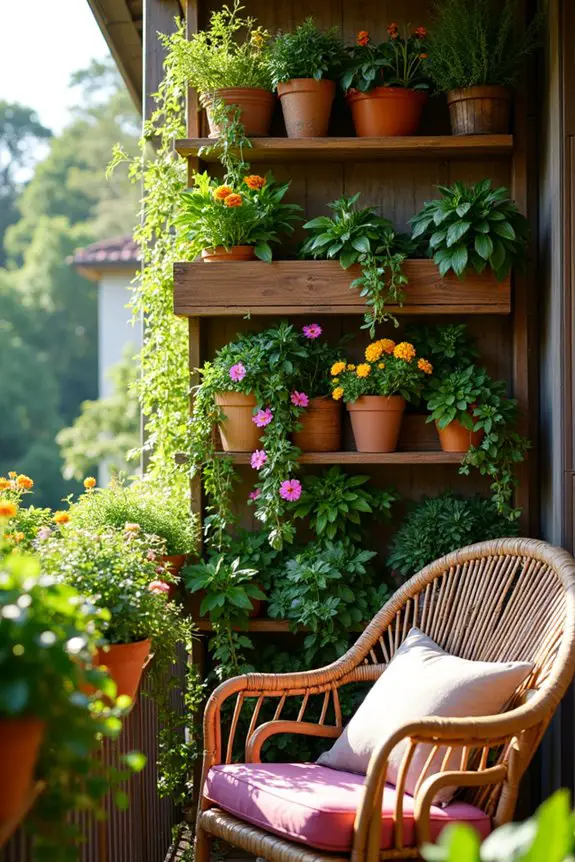
Let’s plunge into the enchanting world of Feng Shui, a design philosophy that harmonizes your environment with nature. Integrating this ancient practice into your balcony garden not only promotes a calm, balanced atmosphere but also maximizes the positive energy flow, or “chi,” within your space.
It’s like giving your outdoor oasis a spiritual makeover that brings a sense of peace and serenity. Who wouldn’t want that?
First things first, think about the placement of your vertical garden planters. In Feng Shui, the best zones for growth are the eastern and southeastern areas, associated with health and abundance. If you can, orient your vertical planters in these directions to let the sunlight pour in and max out your plant power.
This setup not only helps your greenery thrive but also attracts good fortune. It’s like Feng Shui magic that promises bountiful blessings—who wouldn’t want their tomatoes and basil to be lucky?
Next up, let’s chat about colors. Vibrant hues are crucial in Feng Shui. Aim to incorporate a mix of green (the color of growth) with splashes of red or yellow. Imagine your vertical garden adorned with cheerful marigolds, bright geraniums, and variegated leaves—each plant not only beautifying your space but also elevating your mood.
To make it easy, think of colors like a rainbow; the more you mix, the more vibrant and energizing the garden becomes.
Now, let’s not gloss over the significance of materials. Natural elements are Feng Shui’s bread and butter. Use wooden planters, terracotta pots, or even fabric pouches, as they help cultivate grounded energy.
If you’re feeling a bit crafty, consider using reclaimed wood for a rustic vibe. It’s eco-friendly and tells a story. As you plant, really tune into what each material represents: wood symbolizes liveliness and growth, while clay connects you to the ground.
Each substrate can contribute to that magical energy boost.
Ah, and we can’t forget about maintaining balance. Feng Shui encourages harmony, so it’s super helpful to mix plants of different heights and textures. Position your taller plants at the back (to avoid shady hide-and-seek) and layer the shorter ones in front.
A little puzzle action? Sure, but it guarantees every plant gets the sunlight they crave while creating a visually stunning display.
Lastly, a tiny nugget of wisdom I always share? Keep your vertical garden tidy and healthy. Dead leaves or wilting flowers can create stagnant energy.
So, set a schedule—maybe Sunday morning, fresh coffee in hand—to check in, prune, and chat with your plants. After all, they’re your green companions, and even if they can’t speak back, they’ll surely respond to that love and care.
Trust me; they appreciate a little attention more than you think.
8. Seasonal Theme Inspiration
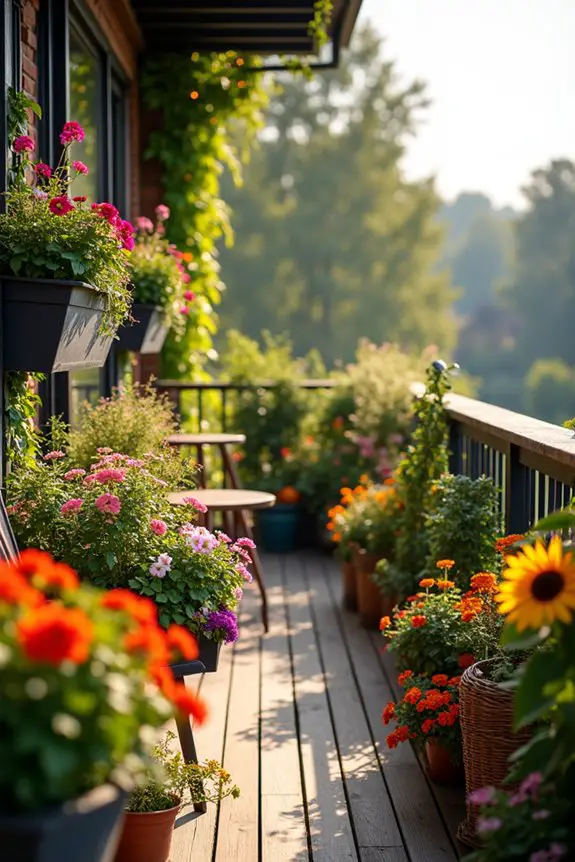
When it comes to elevating the vibe of your balcony garden, embracing seasonal themes is like dressing your greenery in the latest trends. Just imagine your vertical garden planters not only looking stunning year-round but also reflecting the changing seasons. It’s functional and fun—create a garden that feels fresh, inviting, and ever-evolving.
To start off, think about the different seasons and what they signify. In spring, let blooms burst forth with bright colors like pinks, yellows, and whites. Consider adding cheerful pansies, peppy petunias, and heirloom tomatoes to your vertical planters. These beauties not only fill the air with life but also invite the sweet sounds of buzzing bees.
For summer, think tropical vibes; embrace bold colors and lush textures. Varieties like cascading nasturtiums and vibrant sunflowers can sway in the warm breeze, creating an inviting atmosphere. As you may have guessed, fall begs for cozy shades of orange, red, and brown, with marigolds and ornamental peppers adding a harvest feel. And winter? Well, go for evergreen plants or striking winterberry bushes. They offer a stunning contrast against the bare branches and white winter backdrop, turning your balcony into a charming escape.
Now, here’s a fun little tip: when replanting for the seasons, think about what pairs well together. You’d never show up to a potluck with mismatched dishes, right? So, it’s similar with your plants. For spring, combine those lively pansies with trailing greenery like ivy. In the summer, mix ornamental grasses with striking dahlias for height and drama. Want to cozy up your fall garden? Layer chrysanthemums and ornamental cabbage. It’s all about creating a beautiful conversation between the plants, so they can thrive together.
Another juicy detail? Rotate those planters. Not just to keep things fresh, but also to make sure every plant gets its fair share of sunshine. No one likes to be left in the shadows—your plants are no different. Just turning your planters a quarter turn every couple of weeks can work wonders, promoting equal growth and keeping your garden looking vibrant.
And here’s the kicker: don’t forget to add seasonal decor. You can hang mini pumpkins in October, or string fairy lights for winter magic. The little details will pull your theme together and make your vertical garden feel like an extension of your home. Plus, it’s a great excuse to visit your local craft store. Trust me, I’m not speaking from experience or anything (okay, maybe I am).
9. Textured Surface Utilization
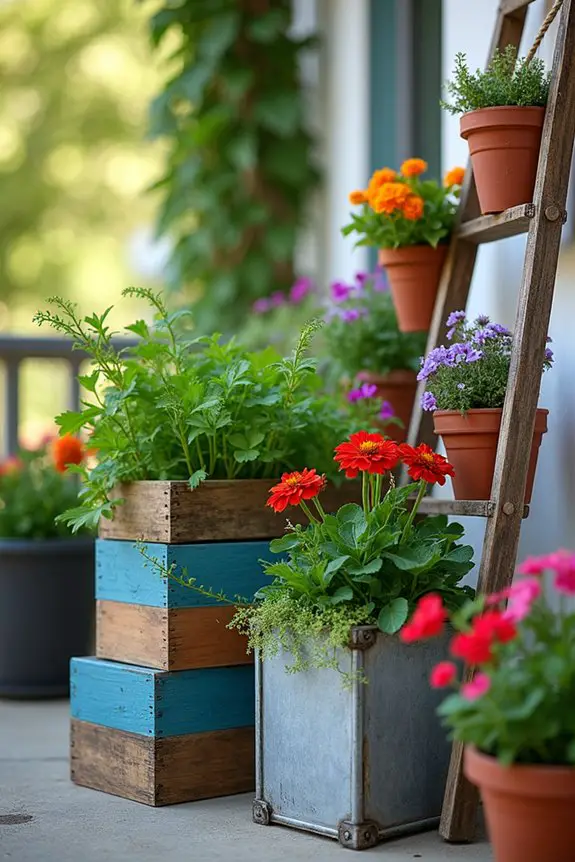
When it comes to making your balcony garden pop, adding textured surfaces to your vertical planters is like inviting a tapestry of colors and sensations into your space. Incorporating different textures not only enhances the visual appeal but also creates a multi-sensory experience. After all, who wouldn’t want their garden to look and feel like a slice of paradise?
First, let’s chat about what I mean by “textured surfaces.” Think about the materials you can use. You might want to mix and match galvanized metal planters for an industrial vibe, alongside rustic wooden boxes for warmth. The contrast between hard and soft surfaces can create a dynamic feel that draws the eye and stirs curiosity. Oh, and don’t shy away from using things that add variation—braided jute ropes, stone, terracotta, or even fabric-covered pots. Just imagine running your fingers over these different surfaces while tending to your plants; it’s like a mini spa day, for you and your garden.
Now, layering is key. Start with larger textured items at the back of your arrangement to give depth (think big burlap sacks filled with herbs). Then, stack smaller items, like ceramic pots or even fabric-wrapped planters, in front. You’re basically building a spicy layer cake of gardening glory—just without the calories. Plus, having different heights creates interest and encourages you to explore your garden from various angles.
One fun tip? Don’t limit your plants to classic containers. Repurpose old crates, wooden pallets, or even small ladders to add unique dimensions to your vertical garden. There’s something unbelievably charming about seeing blooming flowers spilling out of an old wheelbarrow. And hey, if you have a knack for DIY, you can even add texture with paints or finishes—distressed wood looks incredibly chic, or you could opt for textured spray paint for a fun twist.
Get ready to release your inner artist; the garden is your canvas.
While you’re working with textures, remember to think about the plant’s needs. Some need more sunlight—like those prickly succulents that think they’re the stars of the show—while others love the shade, which allows you to play smart with your layout. Layering also means learning what pairs well together, not only in style but in care requirements.
And for a little humor, here’s my personal growth (pun intended). I once planted a beautiful trailing vine in a metal planter, thinking it would thrive. Little did I know, the heat reflected off the metal container turned my lovely plant into a sad little crispy critter. Lesson learned, texture matters not just for style but with plant health too.
As you curate your textured surfaces, let your personality shine through. Each planter tells a story—a travel memento, a gift from a loved one, or a quirky thrift shop find.
10. Organic Shape Integration
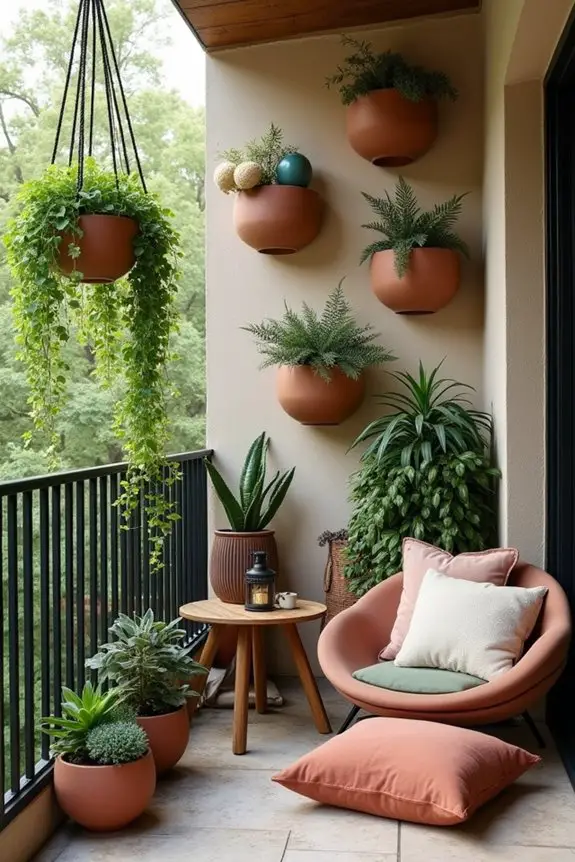
When it comes to creating a balcony garden that’s both functional and pleasing to the eye, embracing organic shapes in your vertical planters can work wonders. Just like nature itself, these flowing, natural forms invite a sense of calm and creativity into your space. They soften the hard edges of urban life, making your balcony feel more like a serene oasis. Plus, who doesn’t want their container garden to feel like a little slice of wild paradise right at home?
To get started, think about how you can introduce curves and waves into your setup. This could mean using rounded planters rather than traditional square ones or even nesting them in a staggered, organic layout. Instead of a rigid row of identical planters, consider placing them at various angles and heights.
Mix in hanging planters that dangle gracefully from a railing—think of them as a nature-inspired chandelier lighting up your garden. If you’re feeling adventurous, you could even use your empty wall space creatively by incorporating wall-mounted planters that zigzag down in an organic pattern, almost like a living waterfall.
Now, let me throw in a handy tip: consider the types of plants that complement these shapes. Curly ferns, trailing ivy, and even plump, round succulents can enhance that organic feel. They naturally lead the eye in a flowing motion, making your balcony garden feel cohesive and dynamic.
And don’t forget to play with colors—go for earthy tones that mimic nature. Someone once told me when I overdid it with vibrant colors, it felt more like a children’s art classroom than a garden. Stick to soothing greens and browns, accented with a splash of something bright, to keep things interesting without going overboard.
If you want to get a bit DIY-savvy, you can even create your own organic shapes using materials like reclaimed wood or curved metal. You could create a planter that swirls a bit—just like the foamy waves of the ocean rolling onto the shore.
It’s okay if the first one you make looks more like a potato than a wave—trust me, that was my first attempt too. With a bit of practice, you can sculpt something beautiful and unique that reflects your personality.
A little humor here—once I tried to arrange plants in perfect straight lines, thinking I was being all chic and sophisticated. Spoiler alert: it looked like a plant prison. Organic shapes tell a different story; they weave in a sense of freedom and joy, inviting you to relax and soak in the beauty around you.
Essential Maintenance Guidelines
Keeping your balcony garden thriving doesn’t have to feel like rocket science. You just need a bit of care and attention.
First, water your plants regularly, but don’t drown them—think of it as giving them a revitalizing drink, not a swim.
Prune dead leaves and flowers often—trust me, they won’t mind.
Consider rotating your plants occasionally to guarantee even sunlight exposure—plants love to soak up those rays, just like we do.
And don’t forget to fertilize every few weeks; it’s like a spa day for your greens.
Mulching helps retain moisture, so grab some and give your pots a nice layer.
Explore those balcony garden ideas, keep it fun, and remember: even the best gardens started with a few weeds and a little love.

